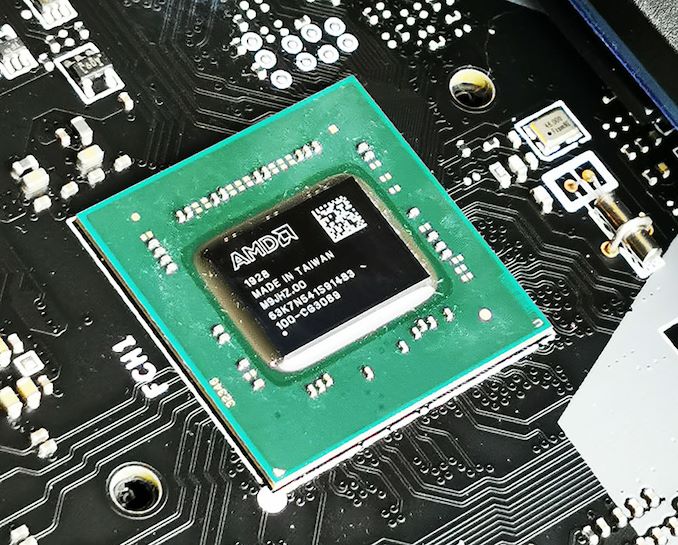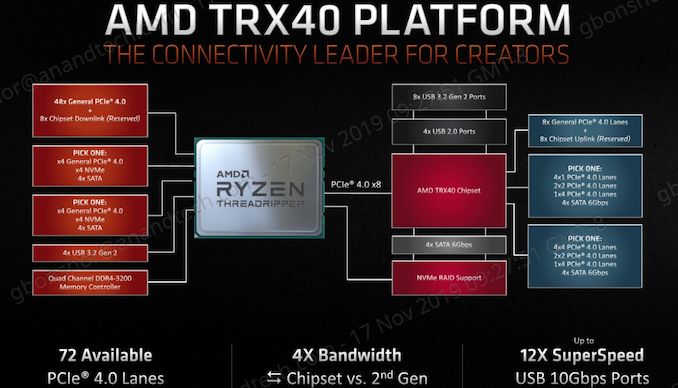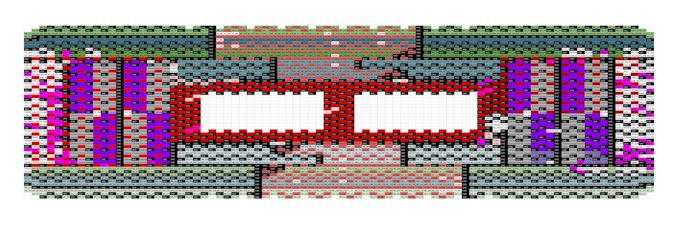The AMD TRX40 Motherboard Overview: 12 New Motherboards Analyzed
by Gavin Bonshor on November 28, 2019 9:00 AM EST- Posted in
- Motherboards
- AMD
- MSI
- Gigabyte
- ASRock
- Asus
- TRX40
- Threadripper 3000
- Castle Peak

It's been a fruitful time for AMD's CPU team over the last year, with a lot of praise heaped on its current processor product stack. The launch of the new AMD Threadripper 3970X 32-core and the Threadripper 3960X 24-core processors has brought the brand new TRX40 chipset to market, and out of all the motherboard partners, there is a new chipset and 12 new motherboards to dissect. In this article, we'll be analyzing the 12 new boards, which as a priority feature enables a PCIe 4.0 x8 link between the CPU and chipset.
The AMD TRX40 Chipset Overview: PCIe 4.0 For HEDT
One of the most important innovations with AMD's switch to the 7 nm architecture was the inclusion of PCIe 4.0. It marked the first consumer hardware to feature PCIe 4.0, which made a huge talking point during the release of the X570 chipset for the Ryzen 3000 CPUs. For the new HEDT processors, we get a new platform, and AMD's new in-house designed TRX40 chipset also integrates PCIe 4.0. This also comes with a PCIe 4.0 x8 connection between the TRX40 chipset and the new AMD Threadripper 3000 processors, quadrupling the bandwidth compared to any competitor's design.
AMD leveraged GlobalFoundries 14nm to build the TRX40 chipset, which in a maximum I/O configuration, offers 16 downstream PCIe 4.0 lanes for peripherals. Like other AMD chipsets, motherboard vendors can select between these PCIe lanes and additional SATA ports, giving board makers some flexibility between PCIe and storage. Combined with the 56 free lanes from the CPU, motherboard makers have a maximum of 72 PCIe 4.0 lanes to work with in building their motherboards.
Another high point is lots of native support for USB 3.1 G2. Up to 12 USB 3.1 G2 ports are supported at the chipset level - this is a massive jump over X399 which supported just two natively. AMD's TRX40 chipset also has support for four USB 2.0, with extra USB 3.1 G1 available through additional controllers integrated into models. This is why some models opt to use USB 2.0 ports to complement the USB 3.1 G2 on the rear panel where required.
One big aspect motherboard vendors have been focusing on is the power delivery. The two new processors for launch day come in at an impressive 280 W TDP, with the newly announced Threadripper 3990X with 64 cores and 128 threads also having a TDP of 280 W. The motherboards have to be solidly built for these, so it's unlikely we will see something 'cheap' in this market space.
| AMD TRX40 and X399 Chipset Comparison | ||
| Feature | TRX40 | X399 |
| PCIe Interface (to peripherals) | 4.0 | 3.0 |
| Max PCH PCIe Lanes | 72 | 66 |
| USB 3.1 Gen2 | 8 | 2 |
| Max USB 3.1 (Gen2/Gen1) | 12/? | 2/14 |
| DDR4 Support | 3200 | 2933 |
| Max SATA Ports | 20 | 12 |
| PCIe GPU Config | x16 x16/x16 x16/x8/x16+x8 |
x16 x16/x16 x16/x8/x16+x4 |
| Memory Channels | 4 | 4 |
| Integrated 802.11ac WiFi MAC | N | N |
| Chipset TDP | 15 W | 5 W |
| Overclocking Support | Y | Y |
The biggest differences from TRX40 from the previous X399 chipset is the addition of PCIe 4.0 replacing the older PCIe 3.0. This brings extra bandwidth advantages for PCIe devices, such as M.2 drives as the PCIe 4.0 SSD controllers mature. The TRX40 chipset is based on the 14 nm process node from Global Foundries.
The high TDP was one of the caveats of the mainstream X570 chipset, due to the higher power requirements of PCIe 4.0. As a result, motherboard vendors implemented actively cooled heatsinks to help keep the chipset cool. With TRX40, we are in the same ballpark for chipset TDP, however with the beefier CPUs supported, there's going to be a variety of designs.
A big thing to note is that TRX40 based motherboards do not support the first and second generation Threadripper processors, eg, TR 1950X. TR 2990X. This means the AMD Ryzen Threadripper 3970X, 3960X, and next years Threadripper 3990X are the only models currently compatible with the TRX40 chipset.
AMD SP3 Versus sTR4: Same Number of Pins, Different Layout
AMD's transition from PGA to LGA processors at the high-end is a shift that users have gotten used to. Each pin in the socket obviously correlates to power, ground, data, and has to be built as such. Both the SP3 and sTRX4 share the same pin counts, but the move to a wider PCIe 4.0 x8 connection to the chipset has necessitated a fundamental change to socket pin outs in order to compensate. This is why the sockets are incompatible with older processors.

sTR4 socket pin layout on TRX40
AMD states that even though both sockets have the same 'keying' (the plastic bits that stop you installing wrong processors), they have engineered the ID pins such that using a new processor in an old motherboard, or vice versa, will just cause the system not to boot, rather than break it. We're going to take AMD's word for that, rather than potentially break an expensive CPU/motherboard combo.
AMD TRX40 And The Realtek ALC4050HD Audio Codec
All of the twelve TRX40 models at launch include a Realtek ALC1220 HD audio codec (S1220 for ASUS models), but the vast majority of the twelve also include a Realtek ALC4050H codec. We thought this was odd, so reached out to all of the vendors to find out what was going on. Turns out something really interesting.

Realtek ALC1220 and ALC4050H audio codecs on the MSI Creator TRX40
It turns out that AMD did not include any onboard passthough audio in the chipet. That means that all the motherboard vendors that are using a Realtek HD audio codec for the rear audio have had to include the ALC4050H audio codec to bridge the USB to the I2S. The Realtek ALC4050H is used to integrate a bridge between the chipset and USB 2.0 to give the Realtek ALC1220 all the necessary connectivity to the onboard audio. Most of the boards in the stack use the ALC4050H codec to power the 3.5 mm microphone input on the rear panel, as well as the front panel audio as not to waste its capability.
Naturally, we asked AMD about this. The official response from AMD reads
The TRX40 platform does not support the HD audio interface used on most desktop and mobile processors.
This means that it is down to the vendors to implement a USB audio device (Realtek ALC4050H) to enable use with the HD audio codecs on TRX40 models.
The TRX40 Product Stack: 12 New Motherboards Unveiled
The launch of both the new Threadripper 3000 series processors, the 3970X and 3960X, has brought about a new wave of models on the new sTR4 socket. There are 12 new TRX40 models in total from the four main vendors, ASRock, ASUS, GIGABYTE, and MSI. It's not just a refresh of the older X399 hardware - the TRX40 chipset is a completely reworked design with many benefits including better componentry, more features from the chipset itself, and most notably, the TRX40 chipset is the first HEDT platform to include PCIe 4.0.
With more models expected to be announced over the coming months, below is a list of the current TRX40 product stack at launch on the 25th of November:
| TRX40 Motherboards Available at Launch (11/25) | |||
| Model | Size | Price (Amazon) |
Price (Newegg) |
| ASRock TRX40 Creator | ATX | - | $460 |
| ASRock TRX40 Taichi | ATX | - | $500 |
| ASUS ROG Zenith II Extreme | E-ATX | - | $850 |
| ASUS ROG Strix TRX40-E | ATX | - | $550 |
| ASUS Prime TRX40-Pro | ATX | $450 | $450 |
| GIGABYTE TRX40 Aorus Xtreme | XL-ATX | - | $850 |
| GIGABYTE TRX40 Aorus Master | E-ATX | - | $500 |
| GIGABYTE TRX40 Aorus Pro WIFI | ATX | - | $400 |
| GIGABYTE TRX40 Designare | XL-ATX | - | $630 |
| MSI Creator TRX40 | E-ATX | $700 | $700 |
| MSI TRX40 Pro 10G | ATX | $500 | $500 |
| MSI TRX40 Pro WIFI | ATX | - | $470 |
On the next page is a summary of each board's power delivery system, with each subsequent page containing a brief analysis/rundown of all the individual boards.












109 Comments
View All Comments
Smell This - Thursday, November 28, 2019 - link
Still just a bit bummed .... that 1st/2nd Gen TRs have been left hangin'
As we roll into 2020, we gotta love where AMD is going BUT, here's hoping that Dr Su does not make the same mistakes on HEDTs that Chipzillah has been notorious in making in the past. With DDR5 on the horiZen, could sTRX4 be yet another *2 and Done* in the next 18 months?
I'm all for $800 mobos -- just as long as they don't become $50 moo-boards in January, 2021.
Spunjji - Friday, November 29, 2019 - link
Based on prior experience of AMD processors, it seems more likely that they'd have to offer new boards for DDR5 support but allow the new processors to run in older boards with DDR4.eek2121 - Friday, November 29, 2019 - link
Chances are that the TRX* series of boards will end in 2021 (or 2022 at the latest), when DDR5 is expected to roll out along with possibly Zen 5 (if 2022). That being said, I have an X399 board and a 1950X. I don't see a need to upgrade yet. I may eventually pick up a 2950X next year, but I'm hanging onto this platform. It games pretty much all current games at 4k, with the majority at maximum or high details (even on a 1080ti), and it's excellent for the development and content creation workloads that i do. Don't let the listed benchmarks fool you, the 1950X is capable of much more. Running Linux brings a rather large performance increase due to better thread scheduling among other things. I have no problems running GTA V or any other games that I play, at full 4k and maximum details.Llawehtdliub - Saturday, November 30, 2019 - link
At 30fpsscineram - Wednesday, December 4, 2019 - link
300.masmosmeaso - Thursday, November 28, 2019 - link
question,is the amount of phases important when it comes to performance or having more devices on the motherboard ? if so how many is overkill for these motherboards ?
Hul8 - Thursday, November 28, 2019 - link
Those power delivery components are only for the CPU package, and take all their power input from the auxiliary CPU power connectors (usually 8-pin, 8+4 or 8+8-pin these days).The rest of the motherboard get their power thru the 24-pin.
eek2121 - Friday, November 29, 2019 - link
More phases typically means better performance (thermals, quality of power, power limits) from the CPU, unless the vendor cheaps out on VRMs. I'd stay away from any board offering only a single 8-pin, as that can be a sign they are using lower quality VRMs, fewer phases, etc. Contrary to popular belief, phase doublers don't really hurt anything. A few in the youtube community have tested this, both with a CPU and also with a CPU 'emulator' that plugs into the socket and measures power output.Hul8 - Tuesday, December 10, 2019 - link
The question was about "devices on the motherboard", which I assume means things other than the CPU. That's why I pointed out that the phases are irrelevant to the question.Dragonstongue - Thursday, November 28, 2019 - link
just to say suchjust "cause" the box label as 280w TDP, this does not automatically mean it USES 280w (I am sure Intel or NVDA likely many many others) will lambast the crud out of AMD for this, without giving the "full story"
eg. Intel will say "our product X only is TDP of Y vs this massive 280w number, choose us, save the world" then when the user actually uses said "product X" they find out either A is much much slower than all review sites list it is and/or B, it shoots ACTUAL power use through the roof therefore not matching the "claims" of said product X TDP being "better" than TR gen 3 280w "listed" TDP
Intel, NVDA have far more proven themselves on "fibbing" their numbers to make the sales than AMD has "overall" over the many years I have been involved with (consumer or otherwise) in computing
............
Thanks for the review overall, at least it seems the various "partners" are not being overly foolish in terms of pricing and feature set, MSI IMO even "better" than some of the others (such as ASUS)
I truly hope these turn out to be the "cat's meow" for those whom can afford and use them, it helps AMD, helps their partners, the long run, helps us all
(^.^)